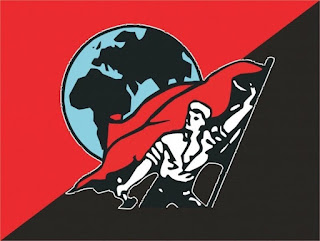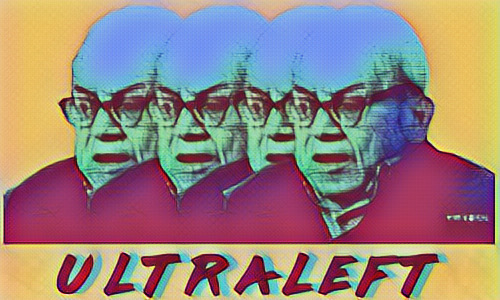Pan-Libertarian Leftisms
Democratic Socialism
Nicos Poulantzas tried to envision how the left could simultaneously champion rank-and-file democracy at a distance from the state and push for radical transformation from within it. Working within the state would aim to produce “breaks” that would polarize the highly conflictual state apparatuses toward the working class, assisted by external pressure from rank-and-file organizations. “It is not simply a matter of entering state institutions in order to use their characteristic levers for a good purpose,” Poulantzas wrote. “In addition struggle must always express itself in the development of popular movements, the mushrooming of democratic organs at the base, and the rise of centers of self-management.”
Anarcho-Communism
Ricardo Flores Magón’s concept of revolution was based on the idea that Mexican workers on both sides of the border had the potential to be the instruments of transformation through their own self-activity. By the outbreak of the Mexican revolution, the Partido Liberal Mexicano (PLM) had produced the Manifesto of 1911, which characterized the Mexican Revolution as one front in a global struggle against the capitalist system. It elaborated a new political vision for liberation the magonistas characterized as “anarchist-communism.”
The Patrido Liberal Mexicano (PLM) of Ricardo Florés Magon, supported by a movement of peasants and indigenous peoples which aimed to expropriate the land, tried to achieve anarchist-communism. The PLM's objective was to revive the community traditions of the ejidos - common lands - and ultimately to extend the effects of this essentially agrarian rebellion to the industrial areas. It was unable to implement its project of agricultural cooperatives organized on anarchist-communist principles.
Anarcho-Syndicalism
Rudolf Rocker wrote on Anarchist-Syndicalism as an introduction to the ideals fueling the Spanish social revolution and resistance to capitalism the world over. Within, he offers an introduction to anarchist ideas, a history of the international workers movement, and an outline of the strategies and tactics embraced at the time (internationalism, federalism, anti-militarism, direct action, sabotage, and the General Strike).
The basic principles of anarcho-syndicalism are solidarity, direct action (action undertaken without the intervention of third parties such as politicians, bureaucrats and arbitrators) and direct democracy, or workers’ self management. Anarcho-syndicalists believe their economic theories constitute a strategy for facilitating working class self-activity and creating an alternative co-operative economic system with democratic values and production that is centered on meeting human needs.
Cooperativists
For classical anarchists such as Peter Kropotkin, cooperatives, as locally rooted, collectively owned, and federated associations, were vital for building the alternative to the capitalist state system. Kropotkin's most famous book, Mutual Aid, maintains that cooperation within a species has been an historical factor in the development of social institutions, and in fact, that the avoidance of competition greatly increases the chances of survival and raises the quality of life. He contended that mutual aid is a factor that is both biological and voluntary in nature, and is an enabler of progressive evolution.
Libertarian Marxism
Luxemburgism is a Libertarian Marxist ideology that believes that the Dictatorship of the Proletariat, proposed by Marxism should be run by democratic workers councils and unions, rather than a Socialist Party. Luxemburguism, as the rest of the German-Dutch strain of Left Communism, was born from the critique of Marxism-Leninism, putting an emphasis on the need of workers directly managing society, instead of a single party above them. Real democracy in economic life would require, Luxemburg argued, the self-emancipation of the working class. In her final years she forecast the dangers inherent in Lenin’s conception of a revolutionary vanguard party.
Council Communism
Pannekoek was best known for his writing on workers’ councils. He regarded these as a new form of organization capable of overcoming the limitations of the old institutions of the labor movement, the trade unions and social democratic parties. Basing his theory on what he regarded as the practical lessons of the 1917 Russian Revolution, Pannekoek argued that the workers' revolution and the transition from capitalism to communism had to be achieved by the workers themselves, democratically organised in workers' councils.
Autonomism
Unlike other forms of Marxism, autonomism emphasizes the ability of the working class to force changes to the organization of the capitalist system independent of the state, trade unions or political parties. Autonomists are less concerned with party political organization than are other Marxists, focusing instead on self-organized action outside of traditional organizational structures. Autonomist Marxism is thus a "bottom-up" theory: it draws attention to activities that autonomists see as everyday working-class resistance to capitalism, for example absenteeism, slow working, and socialization in the workplace.
Enter Antonio Negri, the main theorist of the autonomists. His background was in Operaismo, “workerism”, a brand of Marxism that focused on the conflict between labor and capital in the workplace. This was a reflection of a very confident working class that had been defying both the bosses and, often, the trade union leadership. The main thrust of this perspective was the idea that the improvements in capitalism through the welfare state were all brought about by working class resistance. Negri’s contribution was to argue that exploitation takes place, not just at work where profit is extracted from workers, but throughout society. In an illogical theoretical leap, he concluded that everyone who is not a direct owner becomes a member of the working class and profit is made from their labor. The industrial “mass worker” is thus replaced by the “social worker.” This new working class includes students, the unemployed and the most marginalized sections of society.
Platformism
Platformism is a form of anarchist organization that seeks unity from its participants, having as a defining characteristic the idea that each platformist organization should include only people that are fully in agreement with core group ideas, rejecting people who disagree. It stresses the need for tightly organized anarchist organizations that are able to influence working class movements. Platformist groups reject the model of Leninist vanguardism, instead aiming to "make anarchist ideas the leading ideas within the class struggle". According to platformism, the four main principles by which an anarchist organization should operate are ideological unity, tactical unity, collective responsibility and federalism.
Malatesta would advocate a “wait and see” attitude to questions on post-revolutionary economic organization as a means of advocating greater tolerance between the various strands of social anarchism he encountered throughout his lifetime. Closer to the platform, the ‘Anarchist Program’, written by Malatesta and adopted by the Italian Anarchist Union in 1920, also demands the “reconstruction of the family in such a way that it results from the practice of love, freed of any legal chain, any economic or physical oppression, any religious prejudice” and concludes “we want bread, freedom, love and science for all”. Today pro-organizationalist anarchists, calling ourselves “platformists” agree with Malatesta about the need for two types of organizations: the mass organization and the narrower revolutionary organization with more political agreement.
Market Anarchism
Benjamin Tucker's contribution to individualist anarchism was as much through his publishing as his own writing. Tucker was also the first to publish an English translation of Max Stirner’s The Ego and Its Own. Tucker said socialism was the claim that "labor should be put in possession of its own" while holding that what he respectively termed state socialism and anarchistic socialism had in common was the labor theory of value. Instead of asserting as social anarchists that common ownership was the key to eroding differences of economic power and appealing to social solidarity, Tucker's individualist anarchism advocated distribution of property in an undistorted natural free market as a mediator of egoistic impulses and a source of social stability rooted in a free-market socialist system.
Market Anarchism stresses the value of radically free markets, termed freed markets to distinguish them from the common conception which these libertarians believe to be riddled with statist and capitalist privileges. Proponents of this approach distinguish themselves from right-libertarians and strongly affirm the classical ideas of self-ownership and free markets while maintaining that taken to their logical conclusions these ideas support anti-capitalist, anti-corporatist, anti-hierarchical and pro-labor positions in economics; anti-imperialism in foreign policy; and thoroughly radical views regarding socio-cultural issues.
Minarchist Municipalism
Marxist Henri Lefebvre proposed a “right to the city” in 1968. This idea has been taken up more recently by social movements, thinkers, and certain progressive local authorities as a call to action to reclaim the city as a co-created space: a place for life detached from the growing effects that commodification and capitalism are proposed to have had over social interaction and the rise of posited spatial inequalities in worldwide cities. An idea further developed by geographer David Harvey; they saw the organization of the city as a terrain of struggle between capital and the working class. In the 1980s, Murray Bookchin developed ideas for a “libertarian municipalism” that called for ecologically sustainable cities governed by direct democracy, producing for their needs with cooperatives.





Comments
Post a Comment